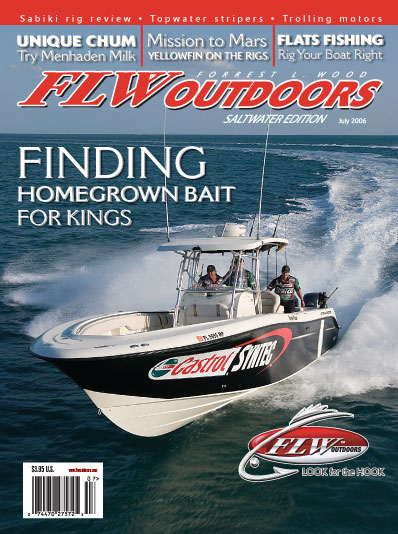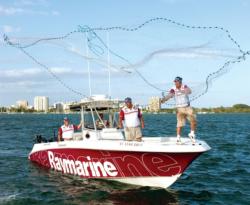Homegrown baits
To catch big kings, you need big, fresh bait

If you think size doesn’t matter, you’d best keep your opinion to yourself during a kingfish tournament. Ask around, and someone’s bound to claim their second cousin’s neighbor’s babysitter’s uncle won a tournament once on a peanut pogy, but save the dice rolling for Vegas.
If you want a sure bet for big kings, use big baits. All things being equal – weather, tackle, skill level – a fat hunk of available flesh is what tournament-winning kingfish seek. Let the juvenile schoolies wear themselves out chasing little meals. The big loners want maximum return on their effort.
John Parks of Jacksonville, N.C., who won the inaugural Wal-Mart FLW Kingfish Tour Championship with Team Early Riser teammates Robert Daugherty and Willie Humphrey, knows well this angling axiom. In both the final 2005 regular-season event and the championship (held the same week in Morehead City, N.C.) Parks nailed his big kings on what he called “Harker’s Island Turbos” – giant pogies caught near their namesake island located in Bogue Sound.
For Parks, an effective live-bait plan marries stealth and strategy with time management for optimal tournament performance. “I like to locate baits a couple of days before a tournament because they’re going to be in the same place on tournament day,” Parks said. “That way we can go right to them and not use a lot of fishing time.”
Local knowledge born from many years of fishing the southern North Carolina coast has taught Parks just where to go. However, anyone anywhere can learn to target premium baits by understanding that the big ones that have avoided predators long enough to grow big demand prime habitat. This means deeper pockets of water away from the porpoises and pelicans that hammer open-water bait schools.
 Boat positioning is critical. Powered by triple 250-hp Yamaha 4-strokes, Parks’ new 35-foot Wellcraft provides plenty of net-throwing and bait-holding space. But, as Parks stresses in his seminars, any boat improperly handled can sink your bait-catching effort.
Boat positioning is critical. Powered by triple 250-hp Yamaha 4-strokes, Parks’ new 35-foot Wellcraft provides plenty of net-throwing and bait-holding space. But, as Parks stresses in his seminars, any boat improperly handled can sink your bait-catching effort.
“If you get the baitfish on that first cast, you’ll get all you need,” he said. “But if you run into the bait and spook them, it’s hard to get another good shot. It seems like it takes forever to get a day’s supply of bait.
“You want to know how the wind and tide are going to push you, so when you cut the engines, you drift right into the baits.”
Parks typically makes a test drift to judge and – if necessary – correct his approach before the live run. At all times, he’s listening and looking for the telltale cues of nearby pogies.
The characteristic “pop” of a menhaden hitting the surface provides an audible cue. Many bait hunters concentrate on detecting pops a rod-length from the boat, but Parks tunes in his long-range hearing and listens for bait several boat lengths away. Early detection affords him time to advise his helmsman of the best approach and to prepare for the throw.
“Once I’ve heard them popping, I’m not listening for the sound anymore – I’m looking for what we call `mooning,'” he said. “It’s a little silver flash the bait makes when they turn under the surface. When I see that, I know I’m in them.”
If he hears a pop right next to the boat, he’ll immediately sling the mesh and steer it as needed. “I try to aim at the sound, but even after I let go of the net, I can still pull it and turn in the air to guide it right toward what I hear or see.”
Parks and crew baby their bait to keep them in top condition. Pursing the net into a 15-gallon barrel partially filled with seawater makes for a much softer landing than dropping bait on the deck. Moreover, pouring pogies from the barrel to the baitwell foregoes the rough treatment of scooping them with a dip net. Such unnecessary harshness isn’t much better than the option Parks considers taboo.
“I hate using penned (previously caught) menhaden,” he said. “If you use the penned bait, they usually won’t last all day and by midday, you’ll have to rebait. Plus, they don’t troll that well because they’re already tired from swimming in the pen all night. They get a rubbery feel to them because all of their slime has been rubbed off.”
Lastly, Parks warns against overfilling livewells: “We try to go with one bait per gallon of water in the well.”